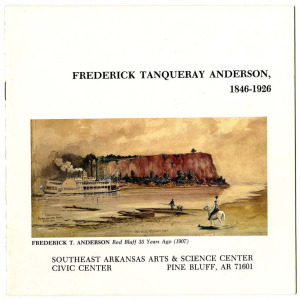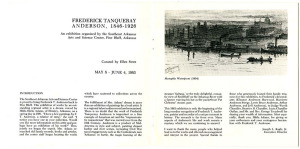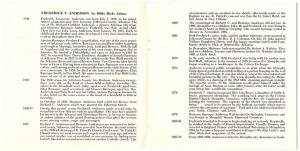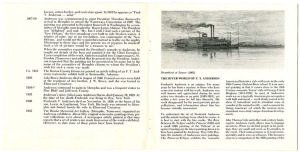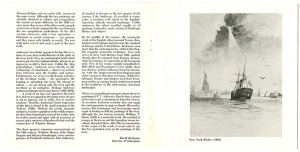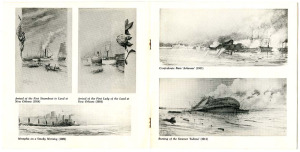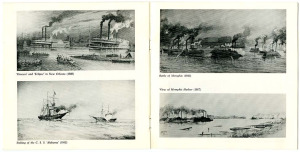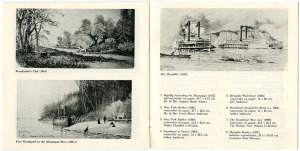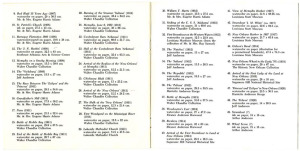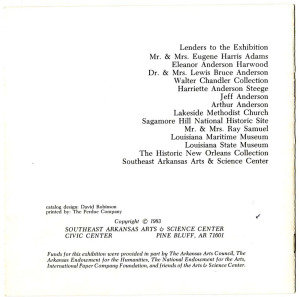Transcript of Arts and Science Center for Southeast Arkansas Frederick T Anderson Exhibition Catalog
FREDERICK TANQUERAY ANDERSON,
1846-1926
FREDERICK T. ANDERSON Red Bluff 35 Years Ago (1907)
SOUTHEAST ARKANSAS ARTS & SCIENCE CENTER
CIVIC CENTER PINE BLUFF, AR .71601
FREDERICK TANQUERAY
ANDERSON, 1846-1926
An exhibition organized by the Southeast Arkansas
Arts and Science Center, Pine Bluff, Arkansas
Curated by Ellen Stern
MAY 8 - JUNE 4, 1983
INTRODUCTION
The Southeast Arkansas Arts and Science Center is proud to bring Frederick T. Anderson back to Pine Bluff. This exhibition of works by an outstanding regional artist is a dream voiced by Hilda Hicks Adams, of Hensley, Arkansas, on a spring day in 1981. "I have a few paintings by F T. Anderson, a relative of mine," she said. "I not ice you have one in your collection. Would you like more information on this artist and perhaps have an exhibition of his work?" Thus, jointly we began the search. Mrs. Adams researched old family records, books and articles, and the center staff began locating the works which have scattered to collections across the country. The fulfillment of Mrs. Adams' dream is more than an exhibition of paintings by a local artist. It is a regional talent rediscovered and reexamined. There is no doubt that the work of Frederick Tanqueray Anderson is important as a fine example of American art and the "impressionistic romanticism" that was carried over from the 19th Century. Anderson is a product of MidAmerica in style and subject, painting elegant harbor and river scenes, recreating Civil War naval engagements such as the Confederate ram 'Arkansas' in battle, the tragic burning of the
Memphis Waterfront (1904 )
steamer 'Sultana,' or the truly delightful, romantic view of Red Bluff on the Arkansas River with a farmer waving his hat as the packetboat 'Pat Cleburne' steams past. This 1983 exhibition is only the beginning of the long overdue recognition of Frederick T. Anderson, painter and recorder of a unique moment in history. The research is far from over. Many aspects of Anderson's life and work remain a mystery which we are continuing to unravel. I want to thank the many people who helped lead us to the works and offered encouragement and interest in the project. Special thanks to those who generously loaned their family treasures for this exhibition, to Frederick's descendants (Eleanor Anderson Harwood, Harriette Anderson Steege, Lewis Bruce Anderson, Arthur Anderson, and Jeff Anderson ), to Judge Wyeth Chandler, Beatrice H. Chandler, Lucia Chandler Outlan, and Mr. and Mrs. George Treadwell for sharing your wealth of information . Most especially, thank you, Hilda Adams, for giving us your enthusiasm and your contageous fascination
with Frederick T. Anderson.
Joseph L. Kagle, Jr.
Executive Director
FREDERICK T. ANDERSON by Hilda Hicks Adams
1846 - Frederick Tanqueray Anderson was born July 1, 1846, on his grandfather's plantation near New Gascony, Jefferson County, Arkansas. The son of Dr. Hichard Cuthbert Anderson, a pioneer Arkansas physician, and Hortense Barraque Anderson, Frederick was their second child. Their first was Julia Laura Anderson , born january 18, 1844. Early in childhood this brother and sister developed a very close bond that was evident throughout their lives.
Antoine Barraque, Frederick's grandfather, was one of the most prominent of Arkansas' early settlers. Barraque was an officer under Napoleon and fought at Marengo, Austerlitz, Jena, Lodi and Moscow. With the fall of Napoleon and the confiscation of his own estate, Barraque fled to America. He land ed at Philadelphia and came to Arkansas in 1816. In 1817, he married Mary Therse Dardenne, daughter of Joseph Dardenne of Arkansas Post. In 1817 or 1819, he settl ed on the Pine Bluff stretch of the Arkansas River and named his new home New Gascony after his old home in France. Having been educated in Paris, Barraque was a man of culture and learning and had a strong influence on the early history of his new community. In 1858, he died at the home of his daughter, Eliza Barraque Smith, in Pine Bluff. His name is preserved in Pine Bluff in the name of one of its principal streets.
1850 - The 1850 census for Jefferson County lists Hortense Anderson, twenty-three years old, as the head of a household in Bolivar township. The others in the household were: Julia, aged seven; Frederick, aged four; Eliza Harraque, aged seventeen; and Frances Barraque, aged ten. Mrs. Anderson must have lived near her father, Antoine Barraque, because he is also listed on the same census as the head of a houshold in Bolivar township. In October of 1850, Hortense Anderson filed a bill for divorce from Richard C. Anderson which was granted the following March.
1850-57 - During this period young Frederick Anderson made several trips by steamboat to New Orleans with his grandfather. This may have sparked his interest in the Arkansas and Mississippi Rivers, as he was to become an ardent admirer of the grand floating palaces that plied the western rivers moving cotton, sugar and passengers.
1857 - Richard C. Anderson and Hortense Anderson were remarried in Jefferson County, Arkansas, and then moved to New Orleans. In a note written on the 1908 ink drawing of St. Patrick's Church, Fred wrote: "St. Patrick's Church where we went to mass and vespers over 51 years ago and where our sainted mother was so mortified on one occasion by finding pews locked. She led us out and never entered another Catholic church. This circumstance and an accident to me shortly afterwards made us the Baptists we are. St. Patrick's convent was then the St. John's Hotel, our first home in New Orleans."
1860 - The remarriage of Richard C. and Hortense Anderson did not last. In 1860, she and her two children, Julia, 16, and Frederick, 14, were living in her mother's home in Bolivar township. This second marriage ended in divorce in November, 1861.
1861 - Both Frederick's sister, Julia, and his mother, Hortense, were married in Jefferson County by the Rev. R. J. Coleman. On July 18, Julia married William Daugherty Harris, and this happy marriage lasted until Capt. Harris' death in 1912, at Bentonville, Arkansas. In December, Hortense Anderson married Dr. Robert A. Watkins. They had two children, Tommy and Hortense, before Dr. Watkins' death in 1965 at Little Rock.
1870 - In the early months of 1870, Frederick was living with his mother near Red Bluff, Arkansas. In the summer of 1870, he moved to Memphis and began working as a bookkeeper in the Cotton Exchange.
1874 - Anderson received public recognition as an artist when the Memphis Daily Appeal published an article telling of a picture hanging on the wall of the Cotton Exchange. It was described as "one of the most natural and beautiful pictures in this city." The work, Rapidly Ascending th e Mississippi (1872), is a drawing of the 'Phil Allin' steaming upstream at night. The reporter wrote: "If Mr. Anderson would place himself under the tutelage of Nast, Morgan or some other famous artist, his talent would soon bring him worldwide recognition."
1878 - Frederick T. Anderson married Miss Lula Bruce, a daughter of Noble S. Bruce, prominent Memphian. The wedding took place in the Central Baptist Church, Memphis, Tennessee, with the Rev. Dr. Landrum performing the ceremony. The capacity of the church was described as being " ... tested to its utmost by the brilliant assembly which met to witness this ceremony of marriage. " Fred and Lula Anderson had three sons: Noble, Clarence and Lewis.
1879 - Hortense Barraque Anderson Watkins died in Memphis, Tennessee, and was buried in Memphis' historic Elmwood Cemetery.
1889-94 - Frederick traveled to Europe to begin studying art seriously. Reputedly, he studied in the studio of French Impressionist, Camill e Pissarro, and traveled in England, France and Switzerland. Returning to Memphis in 1894, he became a frequent contributor to Harper's Weekly, Leslie's and other illustrated magazines of the period.
1903-10 - From 1903-1909, Anderson is listed in Memphis city directories as book
keeper. cotton broker, and real estate agent. In 1910 he appears as "Fred T. Anderson - artist." 1907-09 Anderson was commissioned to paint President Theodore Roosevelt's arrival in Memphis to attend the Waterways Convention of 1907. The painting was presented to President Roosevelt in Washington by a committee of Memphis men headed by Mayor James Malone. The President was "delighted" and said, "My, but I wish l had such a picture of the 'New Orleans,' the first steamboat ever built to ride Western waters. A relative of mine, one of my forefathers, was commander of the 'New Orleans, and would not the wonderful contrast in traffic on the mighty Mississippi in those days and the present era of progress be marked? Such a set of pictures would be a treasure to me.'' When the committee reported the President's remarks to Anderson, he sought out details of the boat and painted it for the Chief Executive. Upon completion of the work, Anderson mailed it to Congressman G. W. Gordon (Tennessee) and asked that he present it to the President. Anderson requested that the painting not be presented in his name but in the name of the committee of Memphis citizens to whom the President's wish for such a scene was made.
Ca. 1915 - The Benton County Democrat printed an article telling of an F. T. Anderson watercolor exhibit held in Bentonville, Arkansas.
1916 - Lula Bruce Anderson died in August of 1916. Funeral services were held at the residence of her brother, J. W. Bruce, and she was buried in Elmwood Cemetery.
Ca. 1916 - Anderson continued to paint in Memphis and was a frequent visitor to Pine Bluff and Jefferson County.
1925 - Anderson 's sister, Julia Laura Anderson Harris, died January 16, 1925. At the time of her death Frederick was living in Rye, New York.
1926 - Frederick T. Anderson died on November 14, 1926, at the home of his son, Lewis, in Larchmont, New York. His body was returned to Memphis and buried beside his wife in Elmwood Cemetery.
1945 - The Brooks Memorial Art Gallery (Memphis, Tennessee) organized an Anderson exhibition. About fifty original watercolor paintings from private collections were shown. A newspaper article printed at that time reports that a set of prints were made from some of the works exhibited. However, to date none of these prints have been located.
Steamboat at Sunset (1903)
THE RIVER WORLD OF F. T. ANDERSON
Frederick Anderson is an enigma. For many years he has been a mystery to those who have come into contact with his work. Anderson was well known and appreciated during his most active two decades as an artist (1895-1915) , yet within a few years he fell into obscurity. His work disappeared for the most part into private collections, and information about him has become virtually nonexistent.
To understand the art of Frederick Anderson and the artistic heritage from which he comes, it is best to start with the late works. The Race Between the 'Eclipse' and the 'Princess' (1920) and a small 1920 painting of the 'Pelican' at an upriver landing are the latest paintings known to have been painted by Anderson. They fully illustrate the maturity of Anderson's river paintings. The Princess/Eclipse exhibits the romantic American illustrative style with roots in the early 19th Century Hudson River school. It is an unusual painting in that it comes close to the 19th Century romantic 'Genre' style of George Caleb Bingham (1811- 1879). In most of Anderson's work we see a typically American preoccupation with light and mood- work firmly rooted in the ideas of 'naturalism' and its attendant sense of wonder at the natural world - and a concern for 'things American' (of which the western rivers steamboat was a truly unique American development).
Like Thomas Cole and other mid-century landscapists, Anderson rarely allows man to impinge on nature. When we do find people in his paintings, they are small and seem as by-standers to the event. Their main purpose is to lead monumentality and to serve as witnesses. This becomes clear in a comparison of the 1920 painting of the
Princess/ Eclipse and an earlier 1911 version of the same event. Although the two paintings are virtually identical in subject and composition, the moods are quite different. In the 1920 version, more than in any of his other works, people seem to be actively engaged in the race between the two magnificent packetboats. In the 1911 version, however, only a few spectators - fishermen or casual watermen - are present, and they pause only briefly to watch. The two craft grow out of and seem a part of the river itself Anderson's riverboats appear to be less the creations of man than embodiments of the spirit of the river itself.
They are monumental craft which seem to ply the river independently, always in an imprecise world to their own. Unlike the 'ship portraitalists,' Anderson never dwells on the 'technology' of steamboats - there is no contest here between man the builder and nature. Furthermore, we never see the human activities of the riverboat world - the passengers, the loading or unloading, the crew, life aboard or a shore - we are shown only the river and the riverboat as its metaphor. Perhaps Anderson understood intuitively George Inness' (1925-1894), " ... A work of art does not appeal to the intellect. It does not appeal to the moral sense. Its aim is not to instruct, not to edify, but to awaken emotion." Possibly, Anderson's finest expression of this idea is found in his small painting of the 'Pelican' (1920). Without the overly romantic mistiness, excessive grandeur or the wildly romantic skies that characterize some of his works, here he evokes mood and spirit with an economy of means and a sureness of brushwork that rival the watercolors of Winslow Homer.
The three greatest American watercolorists of the 19th century, Winslow Homer, John Singer Sargent and Maurice Prendergast, were contemporaries of Frederick Anderson. Like Anderson, all studied in Europe in the last quarter of the century. Like Anderson, all excelled in watercolor, a medium well suited to the English/American attitude toward landscape. Unlike Anderson, the others excelled equally in oil painting, Watercolor, and a variety of landscape idioms and subject.
By the middle of the century, the watercolor work of the English school around Turner, Bonnington and Cottman had become the standard in Europe and the United States. Anderson, even more than his contemporaries, reflects this English romantic watercolor technique. Two early views of New York Harbor from 1894, painted shortly after he returned from Europe, demonstrate his mastery of watercolor in the European style. Few of his works, notably Grandfather's Mill (1911) and Woodcutter's Cart (1914), show any obvious stylistic influence from his encounter with the Impressionist/Post-Impressionist styles current at that time in France. While Prendergast, Homer and Sargent used their European studies as a spring-board, Anderson reverted to the traditions of the mid-century American landscapist.
There is a compelling fascination about the river paintings of F. T. And erson. Rarely does a minor artist exert such a commitment from the viewer. As an artist, Anderson certainly does not equal his contemporaries in range or depth. His work is uneven. His landscapes and housescapes rarely equal in feeling or skill his paintings of the river, although his one known portrait, William T. Harris (1912) is a masterful work. He excelled at images of the rivers and the legendary steam riverboats that plied them. After this re-examination of the corpus of his work, it seems safe to say that his reputation rests on his paintings of the river.
David Robinson
Director of Education
New York Harbor (1894)
Arrival of the First Steamboat to Land at New Orleans (1914), Arrival of the First Lady of the Land at New Orleans (1919)
Memphis on a Smoky Morning (1909)
Confederate Ram 'Arkansas' (1911)
Burning of the Steamer 'Sultana' (1911)
'Princess' and 'Eclipse' in New Orleans (1920)
Sinking in the C. S. S. 'Alabama' (1912)
Battle of Memphis (1913)
View of Memphis Harbor (1917)
Woodcutter's Carl (1914)
First Woodyard on the Mississippi River (1911)
The 'Republic' (1912)
I. Rapidly Ascending the Mississippi (1872) ink/ watercolor on paper, 39.7 x 83.5 cm. Mr. & Mrs. Eugene Harris Adams
2. New York Harbor (1894) watercolor on paper, 35.7 x 26.2 cm Mr. & Mrs. Lewis Bruce Anderson
3. New York Harbor (1894) watercolor on paper, 12.2 x 24.2 cm. Walter Chandler Collection
4. Steamboat at Sunset (1903) watercolor on paper. 12 x 22.5 cm. Arthur Anderson
5. Memphis Waterfront (1904 ) watercolor on paper, 14 x 26 cm. Jeff Anderson
6. Steamboat Around the Bend (ca. 1904) watercolor on paper, 14 x 26 cm. Arthur Anderson
7. The Steamboat 'Rees Lee' (1906) watercolor on paper, 30.5 x 58.5 cm. The Historic New Orleans Collection
8. Memphis Harbor (1907) halftone reproduction, 20.3 x 50.35 cm. Louisiana State Museum
9. Red Bluff 35 Years Ago (1907) watercolor on paper, 29 x 56.5 cm. Mr. & Mrs. Eugene Harris Adams
10. St. Patrick's Church (1908) ink on paper, 27.5 x 13 cm. Mr. & Mrs. Eugene Harris Adams
11. Barraque Plantation 1860 (1908) watercolor/ pastel on paper, 19.8 x 38 cm. Mr. & Mrs. Eugene Harris Adams
12. The 'J. N. Harbin' (1908) watercolor on paper, 32.5 x 63 cm. Southeast Arkansas Arts & Science Center
13. Memphis on a Smoky Morning (1909) watercolor on paper, 15.3 x 50.8 cm Walter Chandler Collection
14. The 'Vicksburg' (1910) watercolor on paper, 13.5 x 27 cm. Jeff Anderson
15. The Race Between The 'Eclipse' and the 'Princess' (1911 ) watercolor on paper, 29.3 x 54.8 cm. Mr. & Mrs. Eugene Harris Adams
16. Grandfather's Mill (1911) watercolor on paper, 17.5 x 36.2 cm. Mr. & Mrs. Eugene Harris Adams
17. Nora (1911) watercolor on paper, 21.3 x 32.4 cm. Mr. & Mrs. Eugene Harris Adams
18. Battle of Mobile Bay (1911) watercolor on paper, 25.9 x 67.5 cm. Walter Chandler Collection
19. End of the Battle of Mobile Bay (1911) watercolor on paper, 26.7 x 67 cm. Walter Chandler Collection
20. Burning of the Steamer 'Sultana' (1911) watercolor on paper, 32.4 x 64.2 cm. Walter Chandler Collection
21. Memphis, June 6, 1862 (1911) watercolor on paper, 30 x 66 cm. Walter Chandler Collection
22. Confederate Ram 'Arkansas' (1911) watercolor on paper, 66.6 x 31.7 cm. Walter Chandler Collection
23. Hull of the Confederate Ram 'Arkansas' (1911) ' watercolor on paper, 32.4 x 63.3 cm. Walter Chandler Collection
24. Arrival of the Replica of the 'New Orleans' at Memphis (1911) watercolor on paper, 12.2 x 21.5 cm. Walter Chandler Collection
25. Chickasaw Bluff (1911) watercolor on paper, 13 x 25.2 cm. Walter Chandler Collection
26. Arrival of the 'New Orleans' (1911) watercolor on paper, 12.2 x 24.2 cm. Walter Chandler Collection
27. The Hulk of the 'New Orleans' (1911) watercolor on paper, 12.3 x 21.4 em. Walter Chandler Collection
28. First Woodyard on the Mississippi River (1911) watercolor on paper, 12.5 x 22 cm. Walter Chandler Collection
29. Lakeside Methodist Church (1911) watercolor on paper, 74.5 x 47.5 cm. Lakeside Methodist Church
30. William T. Harris (1912) watercolor on paper, 35.5 x 27.5 cm. Mr. & Mrs. Eugene Harris Adams
31. Sinking of the C. S. S. 'Alabama' (1912) watercolor on paper, 31 x 60.6 cm. Walter Chandler Collection
32. First Steamboat on the Western Waters (1912) watercolor on paper, 12.5 x 25.8 cm. Louisiana Maritime Museum (from the collection of Mr. & Mrs. Ray Samuel)
33. The 'Natchez' (1912) watercolor on paper, 13 x 27 cm. Jeff Anderson
34. The 'Sultana' (1912) watercolor on paper, 13.5 x 26.5 cm. Jeff Anderson
35. The 'Republic' (1912) watercolor on paper, 13.5 x 27 cm. Jeff Anderson
36. The 'Pelican' (1912) watercolor on paper, 29.5 x 59.5 cm. Harriette Anderson Steege
37. Battle of Memphis (1913) watercolor on paper, 31.6 x 57.5 cm. Walter Chandler Collection
38. Woodcutter's Cart (1914) watercolor on paper, 27 x 47.2 cm. Eleanor Anderson Harwood
39. Breakers (1914) watercolor on paper, 32 x 63 cm. Eleanor Anderson Harwood
40. Arrival of the First Steamboat to Land at New Orleans (1914) watercolor on paper, 28.5 x 16.3 cm. Sagamore Hill National Historical Site
41. View of Memphis Harbor (1917) watercolor on paper, 31.8 x 86.25 cm. Louisiana State Museum
42. Steamboat 'J. M. White' (ca. 1917) watercolor on paper, 22.6 x 69.5 cm Louisiana State Museum
43. New Orleans Harbor in 1867 (1917) watercolor on paper, 21.7 x 63.8 cm. Louisiana State Museum
44. Gideon's Band (1914) watercolor on paper (illustration for a promotional broadside), 47.3 x 74.3 cm. Louisiana State Museum
45. New Orleans Wharf in the Early '70's (1919) watercolor on paper, 29 x 67 cm. The Historic New Orleans Collection
46. Arrival of the First Lady of the Land at New Orleans (1919) watercolor on paper, 28 x 16 cm. Sagamore Hill National Historical Site
47. 'Princess' and 'Eclipse' in New Orleans (1920) watercolor on paper, 23.5 x 36.3 cm. Harriette Anderson Steege 48. The 'Pelican' (1920) watercolor on paper, 14 x 26.5 cm. Jeff Anderson
49. Steamboat (?) ink on paper, 18 x 18 em. Arthur Anderson
50. Wharf Scene (?) ink on paper, 18 x 18 em. Arthur Anderson
Lenders to the Exhibition
Mr. & Mrs. Eugene Harris Adams, Eleanor Anderson Harwood, Dr. & Mrs. Lewis Bruce Anderson, Walter Chandler Collection, Harriette Anderson Steege, Jeff Anderson, Arthur Anderson, Lakeside Methodist Church, Sagamore Hill National Historic Site, Mr. & Mrs. Ray Samuel, Louisiana Maritime Museum, Louisiana State Museum, The Historic New Orleans Collection, Southeast Arkansas Arts & Science Center
catalog design: David Robinson printed by: The Perdue Company
Copyright © 1983
SOUTHEAST ARKANSAS ARTS & SCIENCE CENTER CIVIC CENTER PINE BLUFF, AR 71601
Funds for this exhibition were provided in part by The Arkansas Arts Council, The Arkansas Endowment for the Humanities, The National Endowment for the Arts, International Paper Company Foundation, and friends of the Arts & Science Center.

